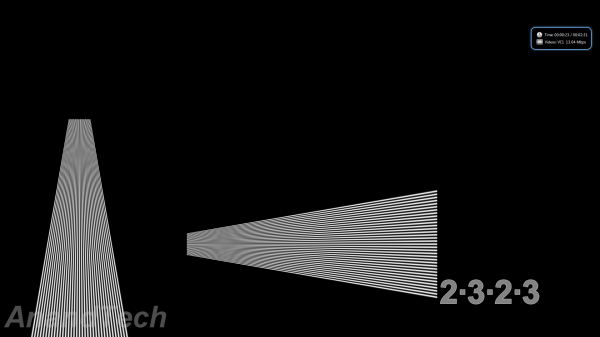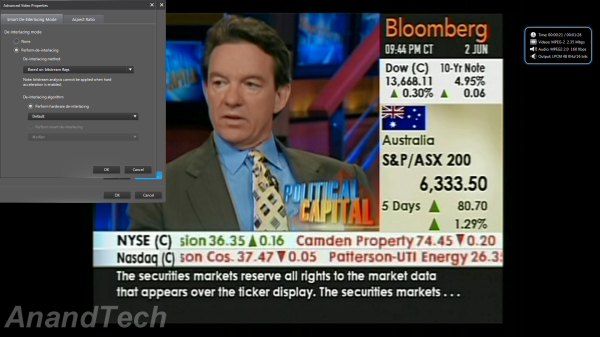ASRock's High-End Vision 3D 252B HTPC Review
by Ganesh T S on May 7, 2012 6:15 AM EST- Posted in
- Home Theater
- Sandy Bridge
- HTPC
- GT 540M
- NVIDIA
HQV scores are meant to be a quantitative metric, but some of the aspects deserve further coverage. In earlier reviews, we had provided screenshots of the Cheese Slices test in order to show deinterlacing performance, and in the Llano review, we looked at issues with the chroma upsampling algorithm. In this section, we will see how the GT 540M fares.
Cadence Detection:
The GT 540M obtains the maximum possible score for cadence detection in the HQV benchmarks. But, is it really effective in all cases? We took the Spears & Munsil Wedge Pattern clip for a test drive. The same test clip was used in our Discrete HTPC GPU Shootout piece. In the previous test, only the GT 430 was able to perfectly inverse telecine the clip. The GT 540M managed to retain that ability.
However, some of the other cadences (including those for which the HQV clips were processed correctly) were not properly inverse telecined / deinterlaced. The gallery below provides information on the troublesome patterns.
In addition, videos often have overlaid text which might be of a different cadence. The 'shredded text' resulting from the video processor being unable to do local cadence decisions often ruins the experience. Some GPUs (like Intel's HD Graphics 3000 in the ASRock CoreHT 252B) take more time to lock onto the cadence compared to others (such as those from AMD). Unfortunately, the GT 540M belongs to the former category. It has problems with both horizontal and vertical scrolling text for more than 5 - 10 frames before locking onto the local cadence.
Deinterlacing:
Instead of the Cheese Slices clip, we have a new deinterlacing testclip (a 480i MPEG-2 stream that we first used in the Zotac ZBOX Nano XS review). As expected, the Vision 3D 252B had no trouble deinterlacing this stream. Further down in this review, we also have rendering benchmarks which show how much the IVTC (inverse telecine / cadence detection / film mode detection) and deinterlacing operations load up the GPU.
We also processed the boat clip from the Spears & Munsil disc, and to tell the truth, there is not really much difference in the quality of deinterlacing that we see between AMD, NVIDIA and Intel. All that matters is whether the GPU is powerful enough to deinterlace content at a given frame rate and resolution, and suffice to say that the GT 540M has no problems even with deinterlacing 1080i60 content (as we will see in a later section).
Chroma Upsampling:
The HQV CUE / ICP testclip was used to check up on the chroma upsampling quality of the drivers. In the gallery below, you will find three screenshots taken in the course of playback (one with PowerDVD, one with ArcSoft TMT and the other madVR set to Softcubic (Softness 70) chroma scaling. Though one can say that the madVR output holds the slight edge, it looks like the algorithm used in the NVIDIA drivers is no slouch
Noise Reduction:
The gallery below presents the noise reduction algorithms in action. Noise reduction strength can be set between 0 and 100, and the gallery below has screenshots for 0, 50 and 100 noise reduction settings for each segment of the clip. The noise reduction algorithms work decently, but the difference is not as stark as, say, what one gets with the AMD GPUs when mosquito noise reduction is enabled.
Contrast Enhancement and Skin Tone Correction:
Simply put, the dynamic contrast enhancement and skin tone correction options in the NVIDIA Control Panel do not work. The gallery below presents the necessary proof.
The color tab in the panel has a contrast setting, but that affects the picture as a whole and doesn't work in the manner that the HQV benchmark guide expects it to. Color enhancement is supposed to take care of skin tone correction, but that was quite ineffective too. We remember seeing the dynamic contrast feature working in a previous driver version, and this just goes to prove that NVIDIA is as guilty of breaking HTPC features in their drivers as AMD is. That said, the driver version v301.24 we tested with is not WHQL certified (I had to move up from v296 because there were some graphics driver stability issues in my setup while testing various HTPC aspects). So, we are willing to cut NVIDIA some slack. However, we hope that NVIDIA is aware of this issue and will take steps to correct it based upon user feedback.






























60 Comments
View All Comments
ganeshts - Monday, May 7, 2012 - link
I agree that the necessary information is spread out over multiple sites / reviews. We will work towards maintaining a database for easy access to all the information from a central point.ggathagan - Monday, May 7, 2012 - link
There's already an extensive guide:http://imouto.my/watching-h264-videos-using-dxva/
http://imouto.my/watching-h264-videos-using-dxva-c...
An alternative to MPC-HC is a Korean product called Pot player:
http://imouto.my/configuring-potplayer-for-gpu-acc...
I've used both players with a GTS 450, an AMD 6950 and an AMD 5670 without issue after following the guides.
aliasfox - Monday, May 7, 2012 - link
First off, I skimmed the article, so forgive me if this is really obvious. Second, I have an admitted Mac bias, so that's where this is coming from. So here goes:With the exception of the Blu-Ray drive and USB3, is there really much that makes this worth so much more than a Mac Mini? I'm thinking the $799, i7, Radeon 6670m equipped model.
$100 to load Windows onto it (if that's your flavor), and $200 should get you a blu-ray player - that leaves that set up $100 cheaper than the ASRock...
The Mac mini does dual display, has HDMI out, and has an optical audio output as well. Admittedly, the SD Card reader on the back is less easy to get to than a reader on the front, and the base HDD is smaller (500 GB).
Different strokes for different folks?
lenkiatleong - Tuesday, May 8, 2012 - link
But Mac mini does not bitstream HD audio to AV as far as i know. And this is the most critical point in my opinion for HTPC.philipma1957 - Monday, May 7, 2012 - link
1.2k for 1.2 k I can have a 2500k cpu a crucial 256gb ssd a 2tb hdd a blu ray from asus 8gb ram a mobo from asus the catch is I need a 14 by 14 by 7 inch case.Any real hi end ht has amps, larger speakers ,large tv. Some subs not one sub.
A gear rack and hiding a case the size of 14 by 14 by 7 on a gear rack is easy.
This is for a design freak with tiny little bose speakers and a wall mount led flat screen.
while that ht is costly ie hi end it makes poor quality sound.
ganeshts - Monday, May 7, 2012 - link
This is a HTPC for the high end home theater. Nothing prevents you from routing the HDMI output from the Vision 3D 252B to an amp / pre-amps and use that to drive the large speakers.aliasfox - Monday, May 7, 2012 - link
Or potentially it's for people who are limited on storage rack space. My five level rack currently houses my blu-ray player, receiver, and dedicated stereo amp, as well as my cable modem and router which live on one shelf.If I were to replace my receiver (currently acting as my pre/pro) with a dedicated pre/pro and another amp to do surround duties, I wouldn't have another entire shelf for a big box htpc - I'd only have the space next to the modem and router to share.
zerorift - Monday, May 7, 2012 - link
Maybe I'm just not seeing this in the review, but what software did you use to record the graphs of power usage?ganeshts - Monday, May 7, 2012 - link
The graphs are from HWInfo. The software is capable of much more than just simple graphing. Here is another screenshot (and the link to the software):http://www.hwinfo.com/images/HWiNFO32_1.png
www.hwinfo.com
nsparadox - Monday, May 7, 2012 - link
I used to build HTPCs back in the day to record shows as a glorified DVR. There's no bundled tuner. What's the point of HTPCs nowadays, assuming you're not using them as a DVR?I can do pretty much all of these things this machine can do with a Blu-Ray player, Google TV, integrated TV software, a Roku box, or just an HDMI out to an existing tablet or laptop PC. And the prices for these approaches ranges from free to $200 depending on what equipment you already have?
Even for massive movie hoarders who want to stream their collection, you can do that with most of these devices.